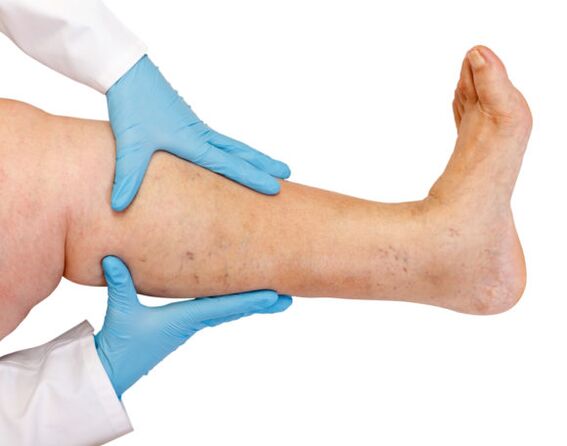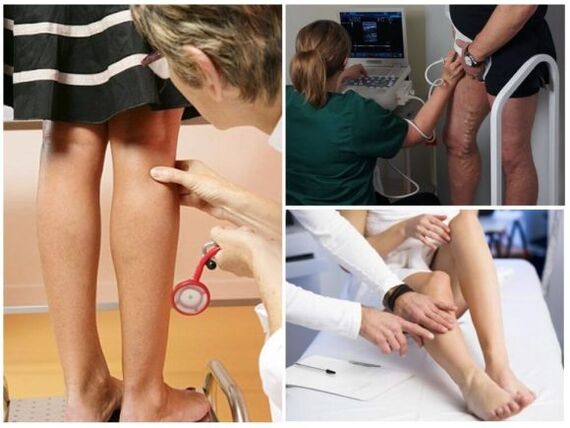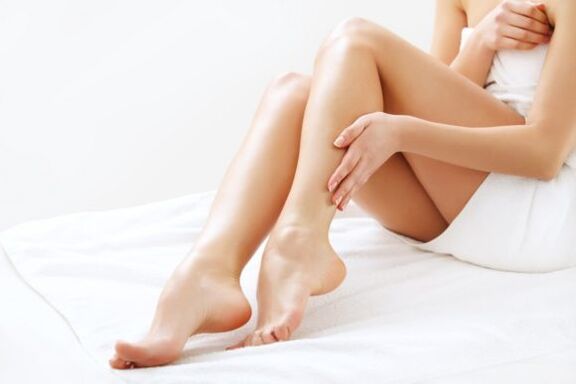Since you read the article, you have faced a problem such as varicose veins.Internal varicose veins are a common and familiar disease for men and women.The article below deals with manifestations of the disease, diagnostic methods and information on how to cure internal varicose veins on the legs.

Symptoms
In a healthy condition, the veins on the legs are practically not visible, they are hidden under the skin and the function normally, without posing problems for a person.But with an illness such as the internal varicose veins on the legs, you can observe an extended venous mesh with knots and in advanced cases with trophic ulcers.
Varicosis is not only a cosmetic defect, but also a very dangerous disease which must be detected in the early stages and consult a phebologist.Varicosis of the veins on the limbs occurs due to the stagnation of the blood with a violation of the function of the venous valves, which helps the blood to rise to the heart and not to descend.
Symptoms of deep veins, which should be careful:
- pigmentation, drought, burn on the lower limbs;
- Swelling and severity for or ultimately;
- pain in the lower limbs;
- The appearance of a venous grid extended on the legs.

At the start of the disease, it is easy to win, but the advanced cases are responsible for complications.
The internal varicose veins on the legs can cause the appearance of trophic ulcers that bleed and heal for a long time, and the most dangerous consequence of pathology is the formation of blood clots.
A thrombus at any time can detach and obstruct important vessels, which can lead to death.Therefore, it is not necessary to ignore such an insignificant disease at first glance.
The varicose veins on the legs have a genetic predisposition.If the nearest parents have such a condition, be careful and perform preventive measures.
Reasons
The reasons for the appearance of a vascular mesh can be:
- excessive load on the legs;
- obesity;
- hormone therapy;
- Pregnancy or menopause;
- embarrassing shoes;
- A long stay on the legs (standing or seated work and lifestyle).
The internal expansion of the veins of the lower limbs is clearly represented in the photo.
Steps of course
The stages of disease development are as follows:
- 1st step: a person practically does not pay attention to their condition, sometimes hesitates after a long step or a serious physical effort.
- 2nd step: at that time, the patient has already started to swell, the intensification of pain, a varicose tenderness appears, night cramps are possible.
- 3rd step: the condition exacerbates, the swelling of the legs is improved, the pigmentation appears, the veins expand even more and darken and their dismissal can be seen.
- 4th step: there is an increase in body temperature and the integrity of the skin is trophic-trophic ulcers.This is the most difficult and dangerous step.But more often than not, it is in this state that people turn to the doctor, ignoring their previous states.
How does the diagnosis of varicose veins go?
Initially, an examination by the doctor is carried out in which the color and the condition of the skin are evaluated, the presence of swelling and visualization of the venous expansion on the legs is verified.
Then comes one of the following studies:

- The diagnostic stallion is the method of duplex synography.A modern ultrasound method, which provides detailed information on the condition of deep and surface ships.It only takes 20 minutes of time.A special patient preparation is not required.The diagnosis is made in ultrasound.
- Dopplerography.The method makes it possible to assess the nature of the blood flow, the state of the valves of the perforating and deep veins, their capacity as a cross country, the presence of blood clots.
- Phlébography refers to X -ray diagnostic methods.A good way to confirm the diagnosis, but requires the introduction of a contrast material in Vienna, after which an X -ray is taken.
In the photo, the doctor assesses the progress and the cost of the cross country of light and also determines the presence of blood clots.
Purchasing samples (bandage) were previously used, but with modern technical capacities, they rarely use them.
What treatment and prevention methods are effective?
Varicosis of the deep veins of the lower limbs can and must be treated in a timely manner!Do not be afraid and do not hesitate to contact a phebologist with such a problem.In the early stages of the disease, you can get rid of easily and painless.
Initially, it is worth excluding the factors that can cause the disease:
- physical activity;
- inappropriate shoes;
- Excess weight;
- Bad hormonal background.
But all the reasons cannot be adjusted, for example, pregnancy or inheritance.In such cases, you must remember prevention.
A good preventive method will be a moderate physical effort (run loose, walk with elevators, swimming, cycling).But at the same time, don't forget to wear compression linen.
You should avoid overheating from the body, so exclude the baths, saunas and tanning.
These small errors during working hours such as throwing the legs on the leg, standing prolonged on the legs or the sitting position will negatively affect the health of your veins, so follow your activity.
Get out of the workplace every half hour and punch, in the case of a long position, change the support leg.Arriving at home, lie on the bed and lift your legs - so that your members rest, the swelling will decrease.
Special exercises
Patients with varicose veins can perform academic exercises to clean blood vessels.
The patient must stand on the socks, raise the heels 1 cm from the ground, then land spectacularly on the heels.You can repeat the exercise 30-50 (no more than 60!) Time 3-5 approaches per day.The pace is slow, but with a pointed landing.With a strong shock, the heel muscles puses and push blood towards the heart.
The internal varicose veins on the legs are treated with medical and surgical methods.

Pharmacotherapy
Treatment with drugs will overcome the disease in the early stages and prevent complications.
Medicines are prescribed for:
- increase the venous tone;
- Improve the lymphatic drainage function (reduce stagnant phenomena);
- Improve tissue nutrition;
- Stop secondary inflammatory reactions.
All drugs should only be taken as prescribed by a specialist!Do not self-mediat, so as not to worsen the state of your health.
Surgical treatment
The surgical method is used under advanced conditions.It consists in eliminating the extended subcutaneous veins and the insolvent scent.It is a more radical treatment method.There are still methods such as stripping and ligature.They also relate to surgery, but are carried out on an outpatient.
Stripping is the elimination of an extended vein using a small probe.Two small cuts are made at the start and at the end of the ship, a tool is started there and fixed at the exit, then the probe with Vienna is eliminated.
Advantages of this method: small cosmetic defects, rapid recovery period, minor pain after intervention.
LIGRAGE - Varicosis in bandage, is more practiced as an additional method for the stripping or elimination of radicals.

Miniflectomy is an operational intervention with minimal access: a special hook is introduced by the incision, it pulls the vein outwards, where it is bandaged and cut.
What method of treatment to use in your case - only a specialist decides.
What does traditional medicine offer?
In folk medicine, carrot juices freshly tight of carrots, spinach leaves, beets, celery and parsley have proven itself.
You should drink 500 ml per day.And special attention is paid to the alcohol consumption diet, as blood plasma consists of water and other trace elements.With a lack of liquid, the blood is thickening.The norm of water for humans: 40 ml per 1 kg of weight.
The internal expansion of the veins of the lower limbs is a serious but dried disease.Listen to your body, at the slightest offense, consult a doctor!












































